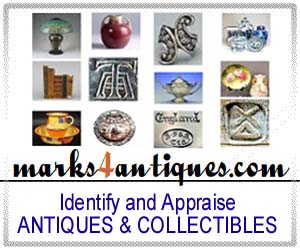IDENTIFYING JEWELRY MARKS:
Researching Signed Jewelry and their Value

If you’re a jewelry enthusiast or collector, you’ll know that identifying the maker, style, and period of jewelry is crucial in determining its value. One of the ways jewelry is classified is by its materials. For example, if it’s made from precious metal and encrusted with valuable jewels, it’s typically classified as fine jewelry. Conversely, costume jewelry refers to items made from non-precious metals and lacking embedded precious stones. Fashion accessories are also divided into these two categories, with most jewelry makers producing fashion accessories of all types and using the same marks.
Identifying Jewelry Marks
Whether you’re buying or selling jewelry, knowing its precious metal content or purity is crucial in establishing its price. Most jewelry is marked with hallmarks, which provide all the necessary information about its origin and precious metal content. Precious metals such as silver, gold, or platinum have specific hallmarks for each country, which usually span a specific time period. These are referred to as standard or assay hallmarks, and they can help in determining the country of origin and age of most jewelry or fashion accessories.
It's important to note that many countries have official hallmarks that are registered and enforced. However, some regions of the world don't, but jewelers from those places often use other symbols that provide enough clues to identify them correctly.
In addition to identifying the precious metal content, other marks can provide valuable information about the jewelry's maker, style, and period. For instance, some jewelry makers have a unique signature or stamp that they place on their pieces, making it easier to identify them. Additionally, the style of the jewelry can also provide clues as to when it was made. For example, Art Deco jewelry was popular in the 1920s and 1930s, while Retro jewelry was popular in the 1940s and 1950s.
Makers' marks on jewelry are yet another significant indication of a piece's value since the reputation of a company or designer is a significant factor in appraising their worth. Rarity and intricate designs are also important considerations for vintage jewelry to retain a high valuation and keep appreciating. However, the main factor in the value of newer jewelry, other than their content in precious metals or stones, is the prestige of the designer. Mass-produced unsigned jewelry, even if made using expensive materials, usually fetch lower prices at auction, and their value is mostly dependent on the purity and overall weight of their precious metal content and/or any precious stones.

Our marks4silver section includes thousands upon thousands of worldwide makers marks, hallmarks, trademarks, and other symbols used to sign jewelry and fashion accessories, regardless of metal and spanning all periods. Most importantly, our specialists are always available to answer any questions for free to our members.
Types and Styles of Jewelry
It's essential to keep in mind that certain genres or styles of jewelry and fashion accessories are more popular depending on current market conditions. However, these trends tend to change rapidly, so collectors should be aware that some pieces may be most desirable or expensive now but may lose some of their value later. For example, Mexican silver jewelry from the 1940s – 1970s was very popular in the 1990s, whereas Modernist jewelry from the 1950s – 1960s era has recently seen a resurgence in popularity and a considerable increase in their prices, especially those made by well-known designers and makers from various Scandinavian countries.
Native-American or American-Indian (Southwest) jewelry reached its peak in popularity around the 1980s- 1990s, yet has retained its value well, especially if made by master artisans with a rich legacy of traditional symbolism related to their native tribe or origin. However, Southwest jewelry's popularity is mainly limited to within the USA, where its significance is best appreciated, but may not be as desirable in other parts of the world, with few exceptions.
Identifying the Value of Vintage and New Jewelry
Jewelry is more than just an accessory; it can be a valuable investment. To determine the worth of jewelry, it is essential to identify the maker, style, and period of the piece. Differentiating between materials used in jewelry, such as fine jewelry made of precious metals and encrusted jewels, and costume jewelry made with non-precious metals and no embedded stones, can also affect the value. Furthermore, fashion accessories can be divided into the same categories, with most jewelry makers also producing fashion accessories using the same marks.

One important factor to consider when buying or selling jewelry is its precious metal content or purity. Hallmarks, which reveal necessary information about the origin and precious metal content of jewelry, are commonly found on most pieces. Specific hallmarks for precious metals like Silver, Gold, or Platinum are used by each country and usually span a particular time period. These are referred to as Standard or Assay Hallmarks and can help determine the country of origin and age of most jewelry or fashion accessories. Although some regions of the world do not have official hallmarks registered and enforced, jewelers from those places frequently use other symbols that give enough clues to identify them correctly.
Vintage jewelry is valued based on its rarity and intricate designs, which can help it retain a high valuation and appreciate over time. On the other hand, for newer jewelry, aside from their content in precious metals or stones, the prestige of the designer is the main factor in determining their value. Mass-produced unsigned jewelry, even if made using expensive materials, usually fetch lower prices at auction, with their value mostly dependent on the purity and overall weight of their precious metal content and/or any precious stones.
Certain genres or styles of jewelry and fashion accessories are more popular depending on current market conditions, but these trends tend to change rapidly. Collectors should realize that some pieces may be most desirable or expensive now but may lose some of their value later. For example, very old pre-Tsarist Russian jewelry is still very popular because of its classic and remarkably ornate detailing, and these do better at auctions in many European capitals since many rich expats usually have a second home there. French vintage jewelry or antique fashion accessories have universal appeal, especially if made by Paris jewelers of the period, since France remains a magnet for famous and talented designers. British-made jewelry tends to be more formal and less ornate, so they seem to be holding their value, but their appeal fluctuates over time as styles fall in and out of vogue.
The most recent jewelry and fashion accessories entrants in the market are designers based in the US or Europe who have their creations mass-produced in other countries like China, India, Thailand, etc. While these designs are beautiful and merit a closer look, their value is highly dependent on the content of any precious metals or stones, rather than the brand or place of origin. In many cases, they sell at a much higher price when new through several TV shopping channels or internet websites but lose their value in the secondary market. Endorsements by famous personalities when selling these on TV do not make them more valuable - these are simply marketing gimmicks to make them more attractive. Additionally, one should be careful with some of the terms used in describing the metal or stones on these, as they tend to be misleading, and it is therefore important to conduct thorough research and understand the different factors that contribute to the value of jewelry before making any purchases or investments.
Conclusion
Identifying jewelry marks is crucial for determining the value of your jewelry. Whether you're a collector or someone looking to buy or sell jewelry, understanding the different types of signed jewelry and their value can help you make informed decisions. Keep in mind that while hallmarks provide valuable information, other marks such as a maker's signature or style are a crucial indication of a company or designer's reputation, making them significant factors in appraising the worth of jewelry. By keeping up with current market trends and seeking the advice of experts, you can make informed decisions about buying and selling jewelry.
Unlock the true value
of your collection with our comprehensive research guides from identifying makers' marks to appraising all kinds of
antiques and collectibles.
Our up-to-date information will give you an accurate understanding of your items' worth. Don't miss out on this
valuable resource - visit our research tools today!
Search our price guide for your
own treasures





